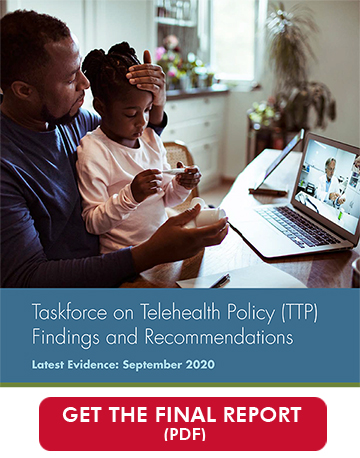 Data Flow and Care Coordination Findings
Data Flow and Care Coordination Findings
By virtue of its digital, direct-to-patient and portable nature—and its use across a wide range of specialties and sites—telehealth is well-positioned to help accelerate the move to a more coordinated, interoperable experience for patients, clinicians and other providers. To do so, the healthcare community needs standards, guidance and best practices on care management, data flow and documentation that will establish a degree of consistency across all care sites. Done right, these guidelines will encourage telehealth “mobility” and maximize its effect, while also smoothing the path for adoption by clinicians and other providers.
Delivering high quality, well-coordinated care to patients at home through telehealth is an important goal. Older adults and people with complex care needs want to live as independently as they can for as long as they can. Telehealth has the potential to improve access to and quality of care, while reducing strain on family caregivers.
Remote patient monitoring (RPM) is a multi-faceted, rapidly evolving subset of telehealth that brings unique data flow and care coordination challenges and opportunities. RPM, unlike most other forms of telehealth, is primarily asynchronous and may require evaluation of inbound data by a clinician. In some instances, RPM involves sharing of discrete services and expertise from one location to another, enhancing system capacity and performance and bridging care gaps. In others, it is part of a holistic treatment plan enabling more frequent, accurate monitoring and consultation between patients and providers without requiring individuals to leave the safety of their homes. This is particularly important for vulnerable populations.
Increasingly, RPM can entail receipt of data from wearables and other devices that may not be related to a specific diagnosis or care plan but may be helpful in assessing and addressing health concerns. RPM has the potential to fill gaps between patients’ visits with their doctors and to leverage the rapidly expanding array of tools that augment patient-generated health data.
Another is to begin moving toward a standard by which all members of a patient’s care team—not just those delivering care via telehealth—update and share a living, virtual, care coordination document While interoperability is a long-standing goal that faces many challenges, there may be ways in which telehealth can uniquely contribute to addressing some of these challenges and drive adoption of a more patient-centered approach to coordinating individuals’ treatment across their care team. If nothing else, many telehealth visits involve the two-way, digital exchange of data and information in a fashion that can reasonably be expected to contain opportunities to share data and records more interoperably.
Data Flow and Care Integration Recommendations
- Policymakers and stakeholders should develop and document clear data sharing standards and guidelines that send a signal to clinicians, other providers and vendors about data transmission and interoperability expectations. These standards and guidelines should become the basis for telehealth platform certification requirements that are aligned with data sharing and documentation guidelines for other care settings.
- These should include provisions that encourage integration of telehealth-related data and care records with all other patient information and strong patient privacy and security criteria to ensure compliance with HIPAA and a requirement to ensure patients have access to their data and that platforms share patients’ data promptly at their request. The goals should be to facilitate interoperability, lower the barriers to telehealth integration and facilitate outcomes analyses that leverage telemedicine data registries.
- The work should build on existing standards and 21st Century Cures Act data sharing and anti-data blocking legislation1 and regulations.2 While the standards and guidelines should serve as a floor of minimum expectations, policymakers should also describe an optimum level of capabilities in these areas.
- Policymakers should immediately convene relevant, third-party entities such as (but not exclusive to) the Interoperability Standards Advisory, Health Level 7, CARIN Alliance, NCQA and radiology’s Digital Imaging and Communications in Medicine (DICOM) to develop the above, with input from vendors, patients, payers, clinicians and other providers, quality measurement entities and other relevant stakeholders.
- CMS should develop and pilot a program that empowers and supports patients receiving care remotely. Patients opting to partake in this “virtual medical home” model would have access to designated patient navigators and other tools to maximize data sharing, care coordination, patient experience and outcomes. The program should be designed to complement and enhance any existing care coordination or Patient-Centered Medical Home services in place and to fully integrate remote care into the healthcare system. These wrap-around services could have the most impact in publicly subsidized managed care arrangements, such as Medicare Advantage, managed Medicaid and Marketplace plans.
- Community health workers or community-based organizations with particular knowledge and expertise in a given region or population could be enlisted to provide this function.
- Higher levels of services would be available to those with more complex needs or challenges.
- To make such a model feasible, policymakers must align payments, care management protocols, penalties and other incentives across programs and payers, and clearly enumerate responsibilities of each party.
- The recent CMS Interoperability Rule moves payers towards adopting FHIR-based standards. In coordination with this effort, funding should be allocated to efforts that promote a shared, living, virtual, patient-centric-care plan among all members of a patient’s team – such as the FHIR CarePlan – and away from siloed, encounter-based documentation. Of course, the shared care plan will require numerous patient consent considerations that must remain at the forefront, especially when it comes to protected health care information like behavioral health, substance use disorder information, or HIV, for example. A pilot test should be conducted to refine and advance the concept.
- Based on past experience, strong accountability models are essential to driving this kind of coordination
- The virtual plan should not restrict an individual provider’s ability to maintain a plan for their portion of the patient’s care, but encourage the use across providers of a dynamic master care plan that accounts for all of the patient’s medical interactions.
Quality Measurement Findings
The quality enterprise should prioritize the use of existing standards and measures when evaluating the quality of care provided by telehealth. Where this is not feasible, measures should be adapted according to clinical guidelines, rather than reinvented to conform to the methods unique to telehealth. For example, telehealth encounters can require getting labs before a visit, ensuring that patients can use and are comfortable with the technology during the visit, and helping patients navigate needed follow-up remotely after the visit. To this end, NCQA responded to the lifting of telehealth restrictions during the COVID-19 pandemic by updating 40 HEDIS® measures to deem services provided by telehealth as equivalent to in-person care for purposes of measure compliance.3
Policymakers should carefully consider the capabilities, limitations and requirements of telehealth as a site of care when measuring the quality of a telehealth encounter, as would be done with any other site. Measurement should focus on whether a telehealth encounter delivers what the patient needs, improves health outcomes, provides an experience the patient can interact with appropriately, and integrates with the patients’ overall healthcare. Moreover, stakeholders should view telehealth as part of a continuum of encounters between patients and clinicians that are coordinated among varying sites, not stand-alone events.
Early findings from COVID-era experience suggest that telehealth may reduce missed appointment (no-show) rates in comparison with in-person visits. In addition, telehealth may have a positive impact in supporting family caregivers as they often play a critical role in patients’ health and well-being. Measure stewards and policymakers should work to quantify each of these potential benefits, where possible, as quality measures are adapted for telehealth, consistent with the goal of improving the patient and family caregivers’ experiences, integrating health and social supports, and understanding patients’ goals and preferences.
Measuring quality provided via RPM is another area that requires attention. Any standards and measures related to RPM should be designed to capture the tangible impact of this modality’s effectiveness, efficiency and closer monitoring of chronic conditions that can prompt earlier interventions that can reduce costly exacerbations, improve outcomes and patient and family caregiver experience, and ensure data flow in a way that maximizes its impact.
Telehealth also offers a “leap forward” opportunity for patient experience measurement. Because the initiation, completion and follow-up for a telehealth visit often occurs digitally, there exists the possibility of assessing patient experience in a more real-time, clinician and other provider-specific fashion that improves response rates and provides faster, more meaningful feedback than current mailed paper surveys. While some existing patient experience metrics may apply equally to telehealth, others will not. This should be a factor in developing and implementing patient experience measures for remote encounters.
Quality Measurement Recommendations
- Measure stewards should carefully and thoughtfully review all measures to determine the need for telehealth adaptations.
- Review should consider how quality measurement could account for telehealth’s unique impact on quality, safety, cost effectiveness, access and outcomes.
- CMS should pilot a patient experience survey linked to telehealth encounters for all types of care, leveraging telehealth’s uniquely digital aspects to improve timeliness, targeting and engagement.
- Lessons learned should help update patient experience measurement across settings to improve response rates and provide faster, more targeted feedback.
Congressional Budget Office Telehealth Estimates
Traditional Medicare stands out from other major insurers and value-based payment models that use telehealth for patient care and savings. This is largely because the Congressional Budget Office (CBO) says that telehealth dramatically increases utilization and costs. CBO does not count potential savings, for example from avoided SNF transfers, reduced re-admissions, better chronic disease management and avoided urgent care visits. Because Congress often requires offsetting new spending, CBO has great influence. However, CBO’s assumptions have led to substantially overestimated telehealth costs. In 2001, after Congress introduced telehealth into Medicare, CBO projected the cost to be $150 million in the first 5 years, or $30 million a year.4 In fact, over the first 14 years, Medicare spent only $57 million—a third less in almost triple the time.5 CBO explained its hesitancy in 2015, saying “Because Medicare coverage of telemedicine is limited, CBO does not have extensive data that would help project how expanding such coverage would affect federal spending.”6 CBO does not use Veterans Administration and Department of Defense data, both of which use telehealth extensively, because they are “closed systems.”
References
1 The 21st Century Cures Act, December 13, 2016.
2 Medicare and Medicaid Programs; Patient Protection and Affordable Care Act; Interoperability and Patient Access for Medicare Advantage Organization and Medicaid Managed Care Plans, State Medicaid Agencies, CHIP Agencies and CHIP Managed Care Entities, Issuers of Qualified Health Plans on the Federally-facilitated Exchanges, and Health Care Providers, Centers for Medicare and Medicaid Services, May 1, 2020.
3 HEDIS, the Healthcare Effectiveness Data and Information Set, is a registered trademark of NCQA.
4 H.R. 5661 Medicare, Medicaid, and SCHIP Benefits Improvement and Protection Act of 2000, CBO, September 2001.
5 Telemedicine Fans Point to CBO’s History of Cost Overestimates, Politico, December 2014.
6 Telemedicine, CBO, July 2015.
-
Save
Save your favorite pages and receive notifications whenever they’re updated.
You will be prompted to log in to your NCQA account.
Save your favorite pages and receive notifications whenever they’re updated.
You will be prompted to log in to your NCQA account.
-
Email
Share this page with a friend or colleague by Email.
We do not share your information with third parties.
Share this page with a friend or colleague by Email.
We do not share your information with third parties.
-
Print
Print this page.
Print this page.
